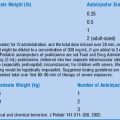Chapter 31 Cardiac Emergencies
1 What are the new pediatric advanced life support (PALS) recommendations regarding the use of endotracheal tube resuscitation medications?
American Heart Association: Currents in Emergency Cardiovascular Care. 16:2005–2006. Available atwww.americanheart.org/downloadable/heart/1132621842912Winter2005.pdf.
2 If ETT resuscitation medications are used, how does the technique differ compared with the previous PALS recommendations?
American Heart Association: Currents in Emergency Cardiovascular Care. 16:2005–2006. Available atwww.americanheart.org/presenter.jhtml?identifier=3012268.
3 Is high-dose epinephrine still recommended in pediatric cardiac arrest?
American Heart Association: Currents in Emergency Cardiovascular Care. 16:2005–2006. Available atwww.americanheart.org/presenter.jhtml?identifier=3012268.
6 What are the initial steps in treatment for a patient with hemodynamically compromising bradycardia?
7 What criteria are considered absolute indications for implantation of a permanent pacemaker for rate support?
8 Give the corrected QT criteria for determining prolongation of the QT interval for differences between children and adults and between males and females
Corrected QT is the calculation of QT measured/√RR interval.
 In children and infants, the maximum normal corrected QT interval (QTc) is 440 msec.
In children and infants, the maximum normal corrected QT interval (QTc) is 440 msec.
Case CL: Diagnosis and treatment of pediatric arrhythmias. Pediatr Clin North Am 46:347–354, 1999.
9 List the associated electrocardiographic findings that may be useful clues to help establish the diagnosis of long QT syndrome
10 What history in a patient presenting with sudden and unexpected syncope would make you consider familial long QT syndrome?
12 List several reasons for an abnormally long QTc interval that is not due to familial long QT syndrome
16 What are the preferred vagal maneuvers used to convert SVT to normal sinus rhythm in infants and children?
 Consider vagal maneuvers if the patient is stable and without symptoms.
Consider vagal maneuvers if the patient is stable and without symptoms.
 Application of a bag of ice with water to the face for 15–30 seconds is effective in 30–60% of patients.
Application of a bag of ice with water to the face for 15–30 seconds is effective in 30–60% of patients.
 In infants, rectal stimulation with a thermometer may be effective.
In infants, rectal stimulation with a thermometer may be effective.
 In children, the Valsalva maneuver via bearing down for 15–20 seconds provides vagal stimulation.
In children, the Valsalva maneuver via bearing down for 15–20 seconds provides vagal stimulation.
 Orbital pressure and carotid massage are not recommended in children.
Orbital pressure and carotid massage are not recommended in children.
18 Which initial steps should be performed in the management of a pediatric patient presenting with an excessively fast heart rate?
19 Describe the appropriate treatment of a patient presenting with hemodynamic compromise (unconsciousness, shock, and disorientation) due to excessively fast rhythm (either wide or narrow complex tachycardia)
20 Give the initial rhythm differential diagnosis for patients presenting with sustained wide complex tachycardia
21 Describe the initial treatment/assessment plans for a patient presenting with sustained wide complex tachycardia not associated with hemodynamic compromise
23 What are the most likely causes of heart failure in neonates presenting to the ED?
Lee C, Mason LJ: Pediatric cardiac emergencies. Anesth Clin North Am 19:287–308, 2001.
26 Describe the difference between “digoxin effect” and “digoxin toxicity”—both clinically and in terms of ECG findings
27 List the expected ECG findings or clinical manifestations of patients who have received overdoses of the following medications:
 β-blockers: Bradycardia, increased PR interval
β-blockers: Bradycardia, increased PR interval
 Calcium-channel blockers: Bradycardia, prolonged atrioventricular node conduction or block
Calcium-channel blockers: Bradycardia, prolonged atrioventricular node conduction or block
 Tricyclic antidepressants: Tachycardia, prolonged QRS, decreased atrioventricular conduction time, VT, ventricular fibrillation, torsades de pointes
Tricyclic antidepressants: Tachycardia, prolonged QRS, decreased atrioventricular conduction time, VT, ventricular fibrillation, torsades de pointes
 Phenothiazines: QTc prolongation, torsades de pointes
Phenothiazines: QTc prolongation, torsades de pointes
 Type 1A antiarrhythmic medications (quinidine, procainamide, disopyramide): Prolongation of QT interval, torsades de pointes, and ventricular tachycardia
Type 1A antiarrhythmic medications (quinidine, procainamide, disopyramide): Prolongation of QT interval, torsades de pointes, and ventricular tachycardia
 Amiodarone: Atrioventricular block, sinus node dysfunction (marked bradycardia), torsades de pointes
Amiodarone: Atrioventricular block, sinus node dysfunction (marked bradycardia), torsades de pointes
28 What potential long-term cardiac toxicity is likely in a patient who has a history of previously treated cancer?
29 List some of the late complications after the Fontan operation that may be encountered in the ED
 Supraventricular arrhythmias: Atrial flutter, atrioventricular reentry tachycardia, atrial ectopic tachycardia, pleural effusions
Supraventricular arrhythmias: Atrial flutter, atrioventricular reentry tachycardia, atrial ectopic tachycardia, pleural effusions
 Thromboembolic complications: Cerebrovascular accident, inferior or superior vena cava syndrome, pulmonary embolus
Thromboembolic complications: Cerebrovascular accident, inferior or superior vena cava syndrome, pulmonary embolus
Tsai W, Klein B: The postoperative cardiac patient. Clin Pediatr Emerg Med 6:216–221, 2005.
30 Describe the ECG changes seen at varying levels of hyperkalemia
41 What are the cardiac complications of Kawasaki disease?
Sundel R: Clinical manifestations and diagnosis of Kawasaki’s disease, 2006. Available at www.uptodate.com.
































